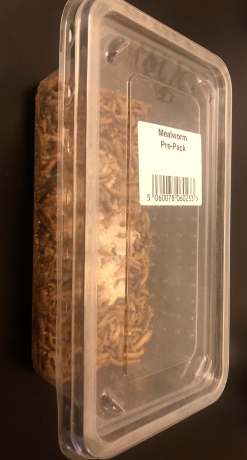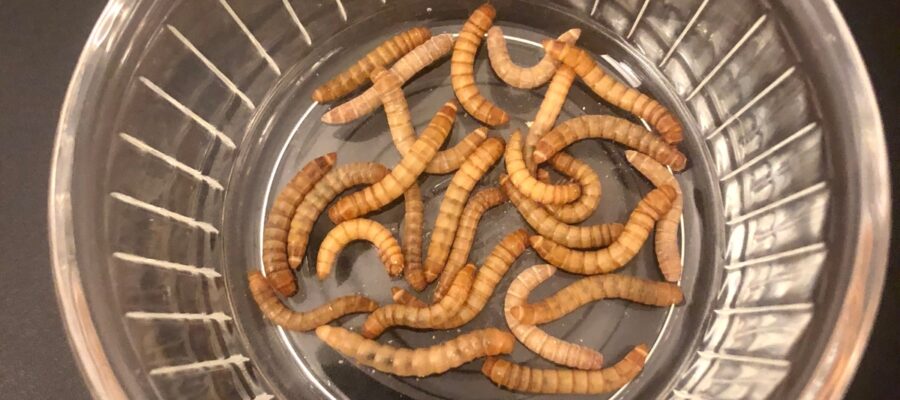Today I’m going to review mealworms, which is one of the most common and readily-available feeder insects out there.
This was the first thing I ever fed to my geckos, as recommended by a local pet store, and it’s easy to see why these are a good feeder to buy for a new leopard gecko owner.
It’s important to feed your geckos a varied diet of live food, because each different insect offers different nutrition and benefits, and also it’s nice for your geckos to have some variety, as their tastes and preferences can change as they age.
For some frequently asked questions I receive around my leopard geckos’ diets, please see my Leopard Gecko Feeder Insects FAQ post and also take a look at my Feeding category which reviews other types of feeder insects.
Mealworm care
Mealworms are a very low maintenance feeder insect, and are easy to keep and feed to your leopard geckos, especially when you have never experienced feeding and caring for live food before.

They usually come in a tub filled with some sort of substrate like bran or oats, and they are absolutely fine to stay in these boxes for the duration of their lives unless you wish to breed them.
At room temperature, the worms will eventually turn into darkling beetles, however if you cool them down, this slows down all of their bodily processes, meaning that they will stay in their “worm” form for longer, but they will probably be immobile until they have warmed up again.
I keep my mealworms on a substrate of oats, and feed them with leafy greens, carrots or potatoes to keep them gutloaded, hydrated and full of nutrition ready to be passed onto my leopard geckos.
It’s important to keep good husbandry and remove food once it has been finished with, because mould and condensation can form, causing the mealworms to die faster. For this reason, I prefer to avoid feeding the mealworms anything that is too juicy, as the mould and condensation will form at a much faster rate.
You know when mealworms have died because they will turn black, so removing these ones, as well as removing the old husks of their moulting/shedding, will also ensure their environment is kept in top condition.
Nutrition
Mealworms are quite high in fat and protein, and lacking in important nutrients, so it is important to always dust mealworms with calcium powder and vitamin D3 powder, especially if you are feeding your geckos exclusively with mealworms (this is not recommended, a varied diet is healthy for your geckos).
Mealworms, have a hard chitin shell which can be hard and can sometimes be difficult for leopard geckos to digest. If you have concerns that your leopard gecko is not digesting its food properly, try to pick out the paler mealworms, as these ones have most recently moulted/ shed this chitin layer, and will be softer.
They smell
Even with good husbandry, I find mealworms to be quite smelly when I open the box. I keep them in a draw so the smell doesn’t usually bother me too much, but compared to other feeder insects I have reviewed, these little guys do have quite an odour.
They move a moderate amount
In order for my leopard geckos to show an interest in food, it has to move around a fair bit. Mealworms are quite wriggly, especially when they are first put in the dish, but I find they can slow down if left too long without being eaten.
They can’t climb smooth surfaces
Mealworms can’t climb up smooth surfaces, so make sure you have a feeding dish which is higher than the length of your mealworms and they will stay where you intend.

I prefer to use insects that can’t climb out of smooth surfaces, because both of my leopard geckos are lazy hunters, and with insects that can get away (such as locusts) my slow geckos sometimes don’t stand a change.
I put my feeder insects in smooth clear ramekins so my geckos can easily catch them, with another added benefit here being the worms tend to stay nicely dusted in calcium powder as they will keep wriggling through it in the bottom of the dish, until they get eaten.
Cost
Mealworms are cheap, plentiful and readily available. It’s also not too difficult to breed them yourself and create a small colony, so you’ll never have to purchase them again.
I tried this once, but it took up a little too much of my time, so I buy them for £2-3 per tub which lasts for weeks.
Summary
Overall, mealworms are a good feeder insect, especially if you have never experienced feeding with live food before. They’re fairly low maintenance, are small enough for baby geckos to handle and are relatively cheap.
Ease of care: 8/10
Nutritional profile: 6/10
Smell/ Noise: 5/10
Movement: 7/10
Ease of containing: 10/10
Cost: 9/10
Get Your Free Leopard Gecko Care Checklist!
Are you ready to give your leopard gecko the best care possible? Download our FREE PDF e-book featuring a comprehensive care checklist!
This handy guide covers everything from habitat setup to feeding and health tips, ensuring your gecko thrives.
👉 Download your checklist now!




